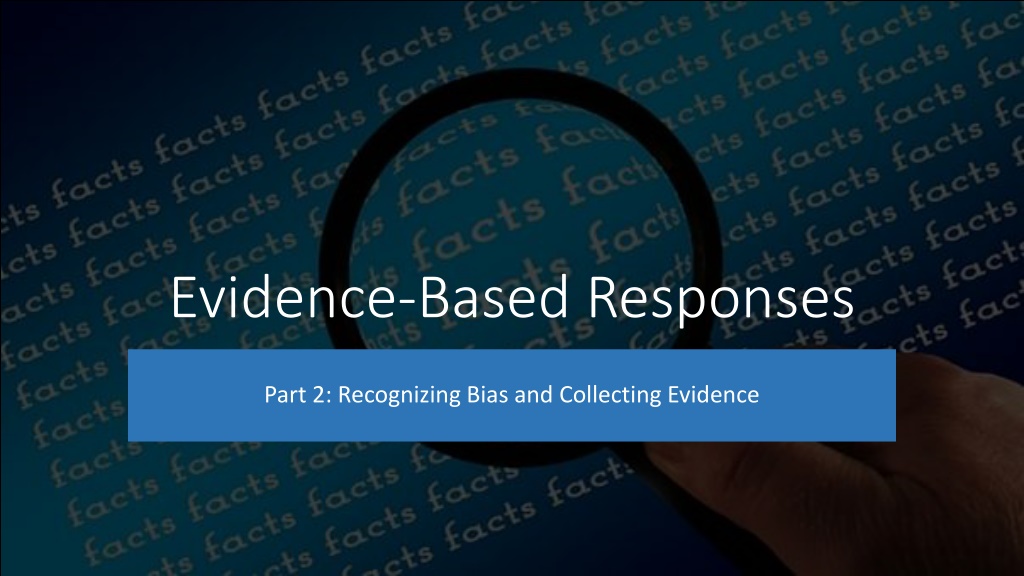Understanding and Avoiding Bias in Evidence-Based Responses
Recognizing bias in oneself and others is crucial when collecting evidence. Different types of bias, such as confirmation bias, can influence decisions and behaviors significantly. By exploring our own thinking and accessing curated resources to learn about bias, we can develop a deeper understanding and make more informed choices.
Download Presentation

Please find below an Image/Link to download the presentation.
The content on the website is provided AS IS for your information and personal use only. It may not be sold, licensed, or shared on other websites without obtaining consent from the author. Download presentation by click this link. If you encounter any issues during the download, it is possible that the publisher has removed the file from their server.
E N D
Presentation Transcript
Evidence-Based Responses Part 2: Recognizing Bias and Collecting Evidence
Recognizing Bias In self and others
Caution! If you notice the following, the source may be biased: Tries to persuade you to think a certain way with no regard for factual evidence The author is unidentifiable, lacks expertise, or writes on unrelated topics Heavily opinionated or one-sided Relies on unsupported or unsubstantiated claims Uses extreme or inappropriate language Is entertainment- based or a form of parody or satire Presents highly selected facts that lean to a certain outcome Pretends to present facts, but offers only opinion Tries to sell you something in disguise
Confirmation Bias and other biases Explicit bias is often easy to recognize as individuals are aware of the prejudices, even if that is not what they call the position. Implicit bias may be unintentional but can affect judgments, decisions, and behaviors. Confirmation bias explains why two people with opposing views can engage with the same evidence and both feel validated. To recognize bias, we must explore our own thinking.
PBS media bias lesson plan Accessing Lesson Plans to Learn About Bias Facing History confirmation and other biases lesson plan From PBS Who, Me? Biased?: Understanding Implicit Bias. Interactive lesson plan Learning for Justice analyzing how words communicate bias lesson plan NEWSeum education recognizing bias lesson plan
Verbs matter as you develop tasks, make sure to use higher order verbs such as justify or create rather than simply state or list. High Impact Content Content matters while a specific topic may be of great interest to a student, the learning should be bigger than the topic. Your professional judgment matters differentiate as needed to provide your students the richest learning experience.
Curated Resources Explain why the resources were selected Provide information about author why you trust the source Explain or evaluate source norms - prereading, what to expect Provide definitions of vocabulary specific to topic and necessary for comprehension Note: you may also choose to require students use specific vocabulary in their response
Why do types of sources matter? Mentor sources teachers select sources that introduce students to the types of responses they seek. Norms of genres or modes different forms of communication have distinct expectations for format. Use of evidence students learn to use evidence effectively in their own responses.
The evidence used does not need to be directly copied from the text. The evidence used does not need to be cited in this context. What does it mean to use evidence from the text?
Factual: synthesis of research, scholarly or expert opinion Logical: explains cause/effect, sequence Types of Evidence Statistical: data-based, analysis of surveys Anecdotal: experience and/or observation
Lets try it Open this document How do penguins stay warm? Print or use digital annotation to identify factual, logical, statistical, or anecdotal information. Note any reflections/questions while reading.
What did you notice about the source: Genre or mode what do you know about the norms? Author is the author credible and reliable? Intended audience -does this influence tone or vocabulary use? Purpose - does it effectively complete the purpose? How? How many different types of evidence did you identify? How is the evidence used in the source? How might the student use the evidence in their response? Does your annotated source look like this? Discussion
Collecting evidence FACTUAL LOGICAL STATISTICAL ANECTDOTAL
End Part 2 Continue to Collecting Sources from Evidence and Writing Responses























